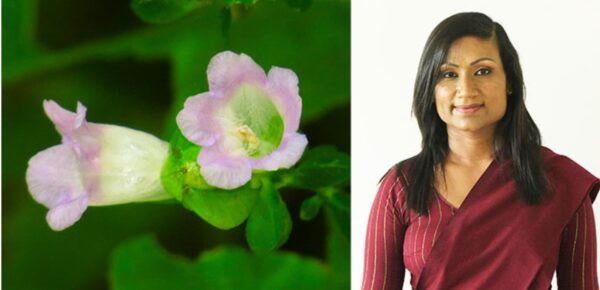New species of Nelu discovered from Knuckles-By Ifham Niza

Source:Island
Lead scientist on Molecular Biology and Plant Taxonomy Dr. Nilanthi Rajapakse of the Department of Wildlife Conservation and her team have discovered a new species of Nelu, Strobilanthes glandulataNilanthi (Acanthaceae) based on morphological and molecular data, from the Knuckles Forest Reserve.
Morphological and DNA evidence were used to distinguish the new plant species from the other closest plant species, S. lupulina.
When contacted Dr. Rajapakse told The Island that Nelu has medicinal value could be used to treat many ailments. Serving as a watershed, it plays an important ecological role. It also helps maintain soil moisture. Young plants are a delicacy of sambur. Many birds and bees come to drink the nectar of the harvested flowers. Nelu is also the host plant of some butterfly species.
Other team members are Nuwan Jayawardena of the Department of Wildlife Conservation, Prof. Cyril Wijesundera of the Institute of Fundamental Studies, Kandy, Prof. Pradeepa Bandaranaike of the University of Peradeniya, Hiruna Samarakoon and Bhagya Hathurusinghe.
During the plant explorations on 22nd April 2016, Nilanthi has found an interesting Strobilanthes population with about 300 individuals growing in the shady places along the stream at Rambukoluwa in the Knuckles Mountain Range. The species named “Strobilanthus glandulataNilanthi” because the epithet glandulata refers to the glandular-hairs on the bracts. It flowers from March to May.
Nearly 450 species of Nelu are spread around the world, most of which are found in tropical and subtropical Asia. With the discovery of the new species, there are about 34 species of Strobilanthes found in the natural environment in Sri Lanka, of which 33 species are endemic to Sri Lanka. Fourteen of these species are protected by the Fauna and Flora Protection Ordinance (FFPO).
The species has the ability to be used as a mature woody twig. Dyes such as indigo, are produced from the leaf extract of most harvested species. Land use for economic crops, illegal use of land, deforestation due to development projects, invasive plant growth, collection for firewood, arson, and climate change threaten plants. Due to these reasons, about 21 species of Nelu that are endemic to Sri Lanka are threatened with extinction.
The team thanked the Director General, Department of Wildlife Conservation (DWC) for the constant encouragement and facilities provided. They also thanked and Department of Forest Conservation, for permitting them to collect samples and the Agriculture Biotechnology Centre, of the Peradeniya University for molecular analysis and the National Herbarium (PDA), the Royal Botanic Gardens, Peradeniya for the assistance in specimen examination, to Rukmal Ratnayake for the line drawings and acknowledged the Ecosystem Conservation and Management Project (EACAMP) for financial support.







